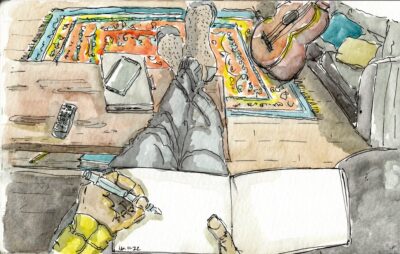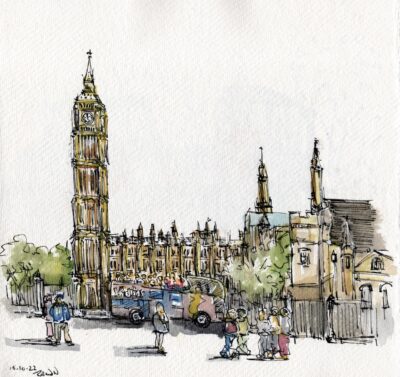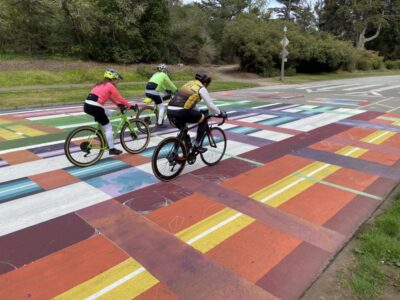 What happens when you close down a city street to cars? More people do non-driving things, like walking, biking, strolling, skating and frolicking in the space normally reserved for motor vehicles. Car-free advocates would say that as greenhouse gas emissions and traffic violence go down, happiness and connection go up — it’s hard to connect with your neighbors while ensconced in two tons of steel.
What happens when you close down a city street to cars? More people do non-driving things, like walking, biking, strolling, skating and frolicking in the space normally reserved for motor vehicles. Car-free advocates would say that as greenhouse gas emissions and traffic violence go down, happiness and connection go up — it’s hard to connect with your neighbors while ensconced in two tons of steel.
Despite the benefits, closing streets to cars can make some people, er — a bit upset. Opponents argue that businesses will suffer (despite evidence to the contrary), congestion will increase (not so, says CityLab) and disabled and elderly people will have less access to public space (there’s a column for that). Like any change that pushes back against car culture, car-free streets face significant challenges.
During the COVID-19 pandemic, cities around the world closed down streets to cars and opened them up for people. Over two years later, some of these experiments were so popular that they are here to stay. Here are four car-free streets that are still going strong or just getting started.
John F. Kennedy Drive in San Francisco
The people of San Francisco have spoken: Keep JFK Drive car-free. Historically, JFK Drive (now known as JFK Promenade) has been closed to cars on Sundays since 1967. When the COVID-19 pandemic shut down most of the city and put a premium on outdoor space for socially-distanced play, it made sense to keep the street car-free seven days a week.
As anyone who has biked, skated or rolled during an open streets event can attest — once you go car-free it’s extremely hard to go back. Making JFK Drive car-free not only increased walking and biking, it turned the street into a space for art, music, celebration and connection.
In April, the San Francisco Board of Supervisors passed a motion keeping JFK Drive closed to cars, along with 40 improvements that would make the park more accessible to disabled people, seniors and others.
The 1.5 mile street in San Francisco’s famed Golden Gate State Park was then the subject of dueling ballot measures this month — Prop J would keep cars out and Prop I would reopen the street to motorized vehicles. Supporters of Prop I argued that permanently closing the drive to cars would exclude people with disabilities from accessing the park. In the end, voters passed Prop J with almost 60% voting “yes” and rejected Prop I with over 60% voting “no.”
Jodie Medeiros, who leads the pedestrian advocacy group Walk San Francisco, says car-free movement at JFK is critical to protecting pedestrians from vehicle traffic. “For two years, we have seen how much people not only love but really need this car-free space,” she told the San Francisco Chronicle. “Car-free JFK is all about our safety.”
According to San Francisco Recreation and Parks, visits to the park increased 36% since the closure, totaling nearly 7 million visits, while over 90% of the streets in the park are still open to cars.
Griffith Park Drive in Los Angeles
It started with tragedy: On April 16, 77-year-old Andrew Jelmart was riding his bike through Griffith Park when he was struck and killed by a speeding driver. While the park is a popular spot for hiking, biking and horseriding with over 50-miles of trails, cars often use it as a shortcut to avoid adjacent freeways. Los Angeles has long been known for its car-centric culture, but Jelmart’s death sparked a movement to make at least part of Griffith Park Drive car-free.
It might seem like a no-brainer that parks should be for recreation, rather than for drivers trying to get from point A to point B faster, but the tragic death of a cyclist drove the point home. By the end of June, the park announced it was temporarily shutting a stretch of Griffith Park Drive to cars. By Aug. 18, the change was made permanent.
As mobility advocates and writers have pointed out, most of the park is still open to cars — the section of Griffith Park Drive that is newly car-free is less than a mile long. However, city officials estimate that the closure keeps about 2,000 cars per day from cutting through the park, making it safer for people walking and rolling.
The city of L.A. has rarely moved this quickly to implement safety improvements for people outside of cars, even in the face of tragedy. In this case, it helped that the Department of Recreation and Parks has sole jurisdiction over Griffith Park Avenue, avoiding some of the public pushback that projects like this often face. In addition to the closure, the park has also announced new plans to curb speeding, calm traffic and improve cycling infrastructure.
34th Ave in New York City
Although not shut down to cars 24/7, one of the most successful car-free street projects is 34th Avenue (now known as “Paseo Park”) in the Jackson Heights neighborhood of Queens, New York City. Currently, the street is car-free every day between 7 a.m. and 8 p.m, turning 26 city blocks into a de facto public park. With the newfound space, the neighborhood hosts a myriad of cultural activities, including yoga, dance, gardening, ESL classes and arts and crafts for kids.
Started in the early days of the pandemic, the 34th Avenue open street project was organized as part of New York City’s Open Streets initiative. Volunteers from the neighborhood put out traffic barriers every morning and started organizing events, activities and games. This year, only 20 miles of open streets remain in the city, down from a high of 83 miles.
The city’s department of transportation says that the project has reduced traffic violence involving pedestrians by a whopping 41.7%. A study conducted by Streetsblog showed a dramatic reduction in all car crashes.
Although the project has sparked controversy in recent months, 34th Avenue is a testament to community organizing and the possibilities of a street centered on people, not cars.
Capel Street in Dublin
Capel Street is a popular retail and restaurant district in Dublin that went car-less in May, making it the longest car-free street in the country — but not without some pushback.
On the face of it, the street – since named one of Time Out’s coolest streets in the world – seems perfect for pedestrianization. Capel is home to such TikTok-famous eateries as Krewe, Bovinity and a secret Asian street food restaurant hidden in the back of a supermarket. A new report out of New York City has found that far from hurting restaurants, car-free streets actually increased business for restaurants enrolled in the Open Streets program. They saw a 19% increase in revenue over previous years, or almost $6 million total during summer 2021.
Capel Street’s car-free journey started gradually, with more space on the street dedicated to outdoor dining during the pandemic. Then, last year, Dublin piloted a program shutting down the street to cars during weekend evening hours for 17 weeks. A public outreach survey found that almost 90% of respondents supported making Capel Street traffic-free, saying that it “improved their experience” of the street.
While some businesses were opposed to the idea, Dublin city councilors voted this month to keep the street closed to motor vehicles.
Before the Pandemic
Even before the threat of a highly-infectious airborne virus pushed cities to begin getting serious about outdoor dining and pedestrianized streets, some cities were already working toward implementing car-free zones in their city centers. In Paris, air and noise pollution pushed Mayor Anne Hidalgo to institute several car-free days beginning in 2015. Reports by the Airparif association, which measures urban pollution levels, suggest that nitrogen dioxide levels fell by nearly a third on the Champs-Élysées, by as much as 40% along the Seine, and about 20% at the Place de l’Opéra, during a car-free day in September 2015. Now, the city plans to ban private vehicles from the city’s historic center by 2024, ahead of the Paris Olympics.
The success of the occasional car-free days in Paris also inspired a movement in São Paulo, Brazil. In 2016, Mayor Fernando Haddad announced a ban on cars every Sunday along the city’s iconic Paulista Avenue. The move has been welcomed, including by the local business owners who were initially skeptical: A 2019 study conducted by a group of local NGOs found that 86% of store owners supported the program. Indeed, many are encouraging the city to expand the ban to Saturday afternoons as well, to encourage more foot traffic and sales.
“With the closing for cars, people started to walk a lot more, to stroll around, and the sales on Sundays grew seven-fold,” one local bookstore manager told Next City. “It was the best thing that could have happened for us. Sundays are now, by far, our busiest days.”
Original article here

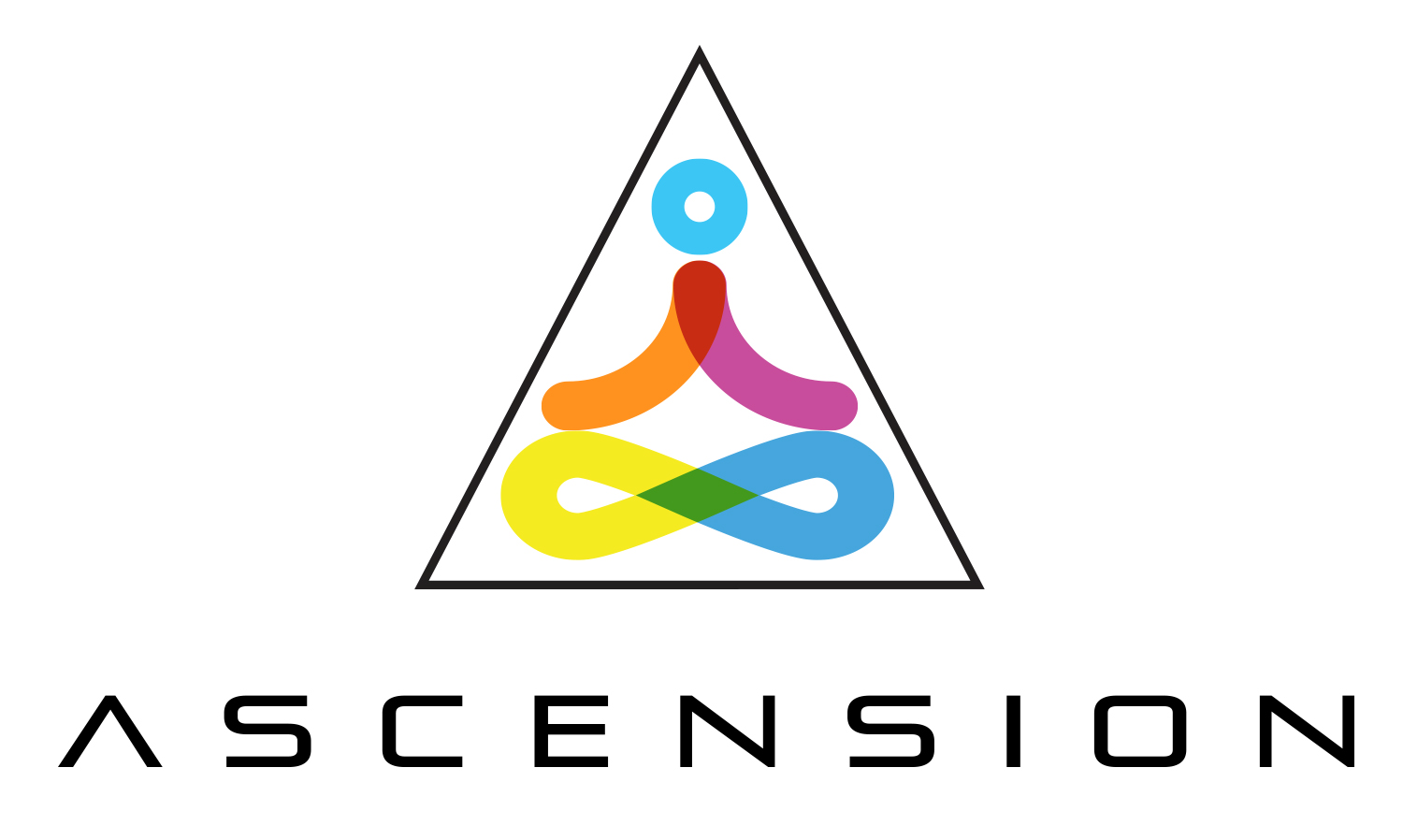
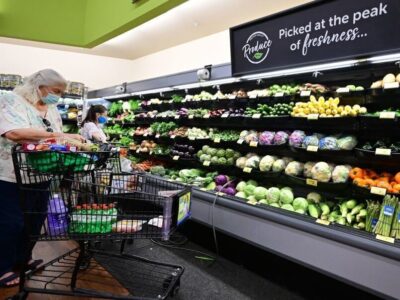 The data are stark: the typical American diet is shortening the lives of many Americans. Diet-related deaths outrank deaths from smoking, and about half of U.S. deaths from heart disease – nearly 900 deaths a day – are linked to poor diet. The pandemic highlighted the problem, with much worse outcomes for people with obesity and other diet-related diseases.
The data are stark: the typical American diet is shortening the lives of many Americans. Diet-related deaths outrank deaths from smoking, and about half of U.S. deaths from heart disease – nearly 900 deaths a day – are linked to poor diet. The pandemic highlighted the problem, with much worse outcomes for people with obesity and other diet-related diseases.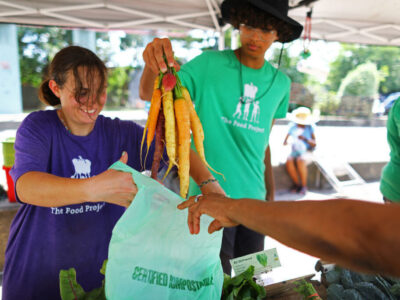 Expand access to dietary and lifestyle counseling
Expand access to dietary and lifestyle counseling We think we want to be happy. Yet many of us are actually working toward some other end, according to cognitive psychologist Daniel Kahneman, winner of the 2002 Nobel Prize in economics.
We think we want to be happy. Yet many of us are actually working toward some other end, according to cognitive psychologist Daniel Kahneman, winner of the 2002 Nobel Prize in economics.
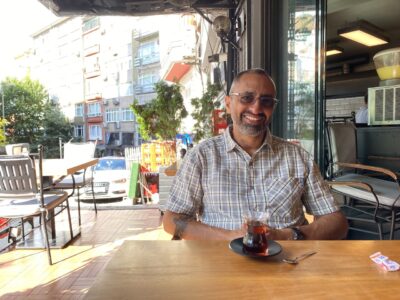 I’m an urban sketcher and painter working primarily around London and the Southeast of England. I concentrate on buildings and street scenes. Since I use my sketchbooks as a form of daily visual diary, my work can also include home scenes and, of course, drawings from my travels. I sometimes get commissions to sketch people’s homes and other memorable places.
I’m an urban sketcher and painter working primarily around London and the Southeast of England. I concentrate on buildings and street scenes. Since I use my sketchbooks as a form of daily visual diary, my work can also include home scenes and, of course, drawings from my travels. I sometimes get commissions to sketch people’s homes and other memorable places.